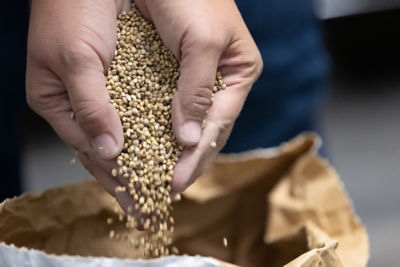Click here to download a PDF version of this spotlight.
» Spider mites feeding on vegetable crops can result in reductions of yield and fruit quality.
» Spider mite infestations are favored by extended periods of warm, dry conditions.
» Natural enemies (predators and parasites) usually keep mite populations in check.
Mites are arthropods, along with spiders, ticks, daddy-longlegs,and scorpions. Adult mites have two main body parts and four pairs of legs. Spider mites live on plants, mostly on the undersides of leaves, and feed by puncturing plant cells. There are over 1,200 known species of spider mites, including the carmine spider mite, brown wheat mite, desert spider mite, pacific spider mite, tomato russet mite, and the twospotted spider mite.1,2,3,4 Of these, the two-spotted spider mite (Tetranychus urticae) is the most common and economically damaging to plants, affecting over 300 plant species worldwide. The two-spotted spider mite (TSSM) is the most common mite species affecting a number of vegetable crops, including tomato, eggplant, potato, melon, and cucumber.1,5

IDENTIFICATION
Spider mites mostly occur on the undersides of plant leaves in small colonies.6 Their life cycle includes four stages: egg, larva, nymph, and adult. The adult TSSM is very small [1/50-inch (1-2 mm) long] (Figure 1). Spider mites can be seen with the naked eye but are easier to identify with the use of a 10X or 20X hand lens. Adults have four pairs of legs, are pale green to orange to pink to cream in color, and have two or more dark spots on their abdomens. Females have oval bodies, while males have pointed abdomens.1,5,7,8 Females can lay 100 or more eggs, which are spherical, clear, and colorless on the undersides ofleaves protected by spider-like webbing. Larvae hatch from theeggs and have spherical, colorless bodies with three pairs of legs. Larvae molt and become nymphs, which have oval, yellow to green to red bodies with one or more dark spots, and four pairs of legs.
DAMAGE/SYMPTOMS
The larvae, nymphs, and adult mites feed on the undersides of leaves. They suck chlorophyll and plant sap from the leaves and inject saliva that can cause discoloration, necrosis, and leaf distortion. Small white to reddish-brown spots (stippling or speckling) appear on the upper leaf surface and the leaf can develop a dull appearance (Figure 2A). Affected plants lose vigor, may be stunted, and defoliate prematurely. Severely infested plants may die. The loss of chlorophyll, leaf distortion, and defoliation can reduce crop yield and quality.2,5,7,8 Mites produce silken webs, initially on the undersides of leaves. However, these webs can eventually cover foliage and flowers with high mite populations (Figure 2B). Once symptoms become visible, the mite populations are well established.1
Spider mites can also vector several plant viruses. The twospottedspider mite is known to be a vector for potato virus Y on solanaceous crops, such as eggplant, pepper, and tomato. Tobacco ringspot virus and tobacco mosaic virus can also be vectored by the two-spotted spider mite.9

HOST CROPS
TSSM is most commonly a problem on beans, tomatoes, and cucurbits (cucumbers, melons, squash, and watermelons), but can also damage celery, eggplant, pepper, sweet corn, and several other vegetable crop species. Several tree fruits, smallfruits, agronomic crops, ornamentals, and weed species are also hosts of TSSM and other spider mite species.5,7,8
CYCLE AND CONDITIONS
The TSSM overwinters as female adults in plant debris, under ground cover, and under bark, as females can tolerate low winter temperatures. All stages of TSSM can also overwinter on plants growing in greenhouses and high tunnels. Adult spider mites are spread by wind and on clothing and tools.1,5,8 A female can lay about 100 eggs over her three-to-four-week life span. Unfertilized eggs hatch into males, while fertilized eggs develop into females. The cycle from egg to adult can take from five to nineteen days depending on the temperature.
Development and population increases are promoted by high temperatures and low humidity.7,8 Spider mites can be washed off the plants by heavy rainfall and overhead irrigation.4 Dust (e.g., dust from adjacent field roads) on the plants can increase the severity of spider mite infestations.2
MONITORING
Successful management of spider mite infestations depends on early detection and treatment.4 Inspect vegetable seedlings for spider mites in the greenhouse before transplanting into the field. Look for stippling on the upper leaf surfaces and webbing on lower surfaces. Look for mites using a hand lens or tap symptomatic leaves over a white sheet of paper and inspect for crawling “dots”.5,7 Scout fields frequently, especially during periods of hot, dry conditions. Initially, focus scouting efforts on field borders where mite infestations are most likely to begin. If mites are detected on the borders, then expand scouting to ten random locations within the field interior. Yellow sticky cards can also be used for detecting the presence of mites.3,5,7
MANAGEMENT
Cultural Practices: Protect populations of natural enemies (predators and parasites) by limiting the use of broadspectrum insecticides, especially early in the season. Reduce plant stress by maintaining appropriate levels of fertilization and irrigation, but avoid excessive levels of nitrogen.2,5,7,8 Manage weeds, such as field bindweed, in and around the field. However, avoid mowing weeds that are already infested with spider mites, as mowing can cause the mites to migrateonto the crop plants. Try to minimize the accumulation of dust on the plants. Row covers can be used to exclude mite colonization early in the season.2,8
Biological Control: Natural enemies (beneficial insects and mites) are usually able to keep spider mite populations in check on field-grown plants.1,7 The western predatory mite (Galendromus occidentalis), sixspotted thrips (Scolothrips sexmaculatus), western flower thrips (Frankliniella occidentalis), lady beetles (Stethorus sp.), minute pirate bug (Orius tristicolor), and lacewing larvae (Chrysoperla carnea) all help keep spider mite populations low. Releasing commercially available predatory mites, such as Phytoseiulus persimilis, may providesome protection for field and greenhouse-grown tomatoes,and the predatory mite Amblyseius fallicis is sometimes used tohelp manage spider mites on greenhouse-grown plants.5
Chemical Control: Several miticides are available to help manage spider mites on vegetable crops, but labeled productsvary with crop species. Consult regional vegetable production and pest management guides and product labels for information and restrictions on application on specific crops. Applications should be initiated when spider mite infestations are first detected and symptoms on plants are observed. If mites are detected on field borders, treat a buffer zone at least 100 feet beyond the mite-infested area. Applications needto reach both the upper and lower leaf surfaces to provideadequate management of spider mites. Spot treat when population buildups are detected, preferably before webbingoccus.1,2,7
Miticide active ingredients listed in regional vegetable production guides for use against spider mites on some vegetables include abamectin (group 6), acequinocyl(group 20B), bifenazate (group UN), bifenthrin, (group 3A), cyflumetofen (group 25), fenbutain oxide (group 12B), fenpyroximate (group 21A), spiromesifen (group 23), and sulfur (group UN). Insecticideal soaps and various horticultural oils can also be used to help manage spider mites, especially in organic production systems. 1,2,3,4,5,8 Always read and followpesticide label directions.
Some miticides can be harmful to bees and other beneficial insects, so care should be taken in selecting and applying products for mite management. Whenever possible, apply insecticides and fungicides late in the day when pollinators are less active in the field.4,7 If making multiple applications, alternate among products with different modes of action to help manage the development of resistant mite populations.5,7
SOURCES
1 Mahr, S. Twospotted spider mite, Tetranychus urticae. Wisconsin Horticulture, Division of Extension. https://hort.extension.wisc.edu/articles/twospotted-spider-mite-tetranychus-urticae/.
2 Natwick, E., Stapleton, J., and Stoddard, C. 2016. Spider mites. UC IPM Pest Management Guidelines: Cucurbits. UC ANR Publication 3454.
3 Aguiar, J., Jimenez, M., and Goodell, P. 2010. Webspinning spider mites. UC IPM Pest Management Guidelines: Eggplant. UC ANR Publication 3475.
4 Ingwell, L. 2020. Mites on the rise. Perdue Vegetable Crops Hotline. Issue 678.
5 Hazzard, R. 2022. Two-spotted spider mite. UMass Extension Vegetable Program. https://ag.umass.edu/vegetable/fact-sheets/two-spotted-spider-mite#:~:text=The%20two%2Dspotted%20spider%20mite,most%20important%20pests%20of%20eggplant.
6 Natwick, E., Trumble, J., and Aguiar, J. 2007. Twospotted spider mite, Tetranychus urticae. UC IPM Pest Management Guidelines: Peppers. UC ANR Publication 3460.
7 Muza, A. 2021. Two-spotted spider mite on vegetables. PennState Extension. https://extension.psu.edu/two-spotted-spider-mite-on-vegetables.
8 2023. Spider mites on vegetables. University of Maryland Extension. https://extension.umd.edu/resource/spider-mites-vegetables.
9 Sarwar, M. 2020. Chapter 20 - Mite (Acari Acarina) vectors involved in transmission of plant viruses. Pages 257-273 in: Applied Plant Virology. L. P. Awasthi, ed. Academic Press.
Websites verified 10/25/2023
ADDITIONAL INFORMATION
For additional agronomic information, please contact your local seed representative. Performance may vary, from location to location and from year to year, as local growing, soil and environmental conditions may vary. Growers should evaluate data from multiple locations and years whenever possible and should consider the impacts of these conditions on their growing environment. The recommendations in this article are based upon information obtained from the cited sources and should be used as a quick reference for informationabout vegetable production. The content of this article should not be substituted for the professional opinion of a producer, grower, agronomist, pathologist and similar professional dealing with vegetable crops.
BAYER GROUP DOES NOT WARRANT THE ACCURACY OF ANY INFORMATION OR TECHNICAL ADVICE PROVIDED HEREIN AND DISCLAIMS ALL LIABILITY FOR ANY CLAIM INVOLVING SUCH INFORMATION OR ADVICE.
5911_279851 Published 11/09/2023




